Present in UK
Reportable in Scotland – see ‘Report a sighting’ below
Scientific name – Cameraria ohridella (C. ohridella)
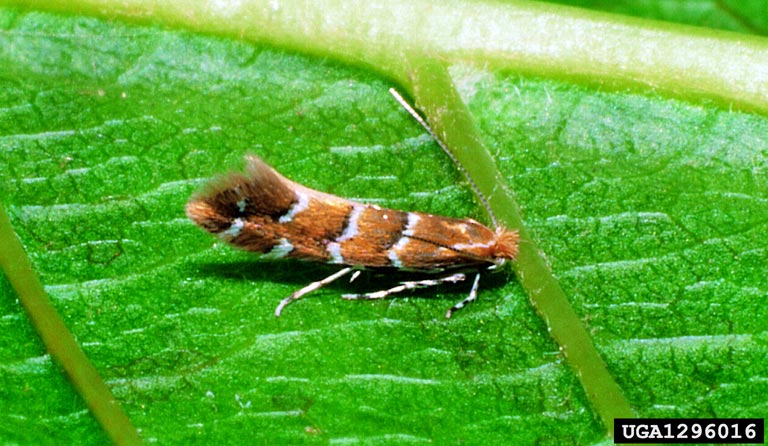 Picture: Gyorgy Csoka, Hungary FRI, Bugwood.org
Picture: Gyorgy Csoka, Hungary FRI, Bugwood.org
The caterpillars, or larvae, of the horse chestnut leaf miner moth (HCLM) are an invasive pest of horse chestnut (trees in the Aesculus genus) and some maple and sycamore (Acer) species. This includes the common or European horse chestnut, or ‘conker’ tree (Aesculus hippocastanum), the most populous species of horse chestnut tree grown in the United Kingdom.
Horse chestnut leaf miner is present in much of England and Wales, and throughout central and eastern Europe. There have been four reported sightings in Scotland, three of which were in Edinburgh. Our map shows where in the UK it was confirmed to be present in 2014, although it will be present in other areas by now.
See ‘Origins and background’ below for more details of its history.
There are 13 naturally occurring species of horse chestnut trees and shrubs (trees and shrubs in the Aesculus genus), all native to the Northern Hemisphere. There is also one hybrid. Susceptibility to HCLM is related to taxonomic and evolutionary relationships, rather than to a specific geographic origin.
HCLM can feed on other Aesculus species in addition to European horse chestnut, although the feeding damage is never as significant on the others as it is on the European species. These include the Japanese horse chestnut (Aesculus turbinata), red-flowering horse chestnut (A. x carnea), Indian horse chestnut (Aesculus indica) and red buckeye (A. pavia).
It can occasionally also attack Acer species such as Norway maple (Acer platanoides) and sycamore (A. pseudoplatanus), especially if they are planted close to a horse chestnut tree.
The pest is not thought to pose a significant threat to any of these species.
Horse chestnut leaf miner does not affect sweet chestnut trees (trees in the Castanea genus).
European horse chestnuts are attractive trees highly valued for their aesthetic appeal, which has led to their being widely planted along riverbanks and in parks in the UK.
At high population densities, HCLM caterpillars can destroy most of the leaf tissue on an individual ae the natural autumn leaf fall. The caterpillars can cause severe damage to horse chestnut leaves on an annual basis. Once established, HCLM will quickly become ubiquitous across European horse chestnut trees at a location.
However, HCLM does not significantly impair the trees’ overall health, and the effect is mostly aesthetic. Research has shown that HCLM can attack up to 75% of the total leaf area on the trees, but that the loss of subsequent photosynthetic leaf tissue only reduces the total carbon assimilation by, at most, an estimated 30-40 per cent over the growing season. The reduction is much less than the total leaf area affected, because the majority of damage caused by HCLM occurs late in the season, after the tree has completed most of its photosynthesis for the year. As such, the general tree condition and stem radial growth are not affected by HCLM, even over repeated annual attacks.
However, infestation decreases the reproductive output of the trees, through a reduction in the weight of seeds (‘conkers’), seedling germination and vigour.
Following an infestation, the trees will usually flush normally the following spring, when they can be attacked again by new generations of the pest which have over-wintered in leaf litter nearby.
HCLM might exacerbate any decline and eventual death triggered by one or more other threats. These can include bleeding canker of horse chestnut, horse chestnut leaf blotch (see ‘Identification and symptoms’ below), leaf scorch, and damage to leaves caused by droughts and floods. Horse chestnut trees with all three of leaf miner, leaf blotch and bleeding canker have been observed. See ‘Our research’ below for details about how we and others are looking into these interactions.
The long-term risk, therefore, is that the combination of threats might cause a decline in the numbers of horse chestnut trees in the landscape as landowners opt to replace them with other species.
Elongate patches on the leaves, starting white (below) and turning brown, are a sign that horse chestnut leaf miner might be present in horse chestnut trees. They are caused by the larvae ‘mining’ through the leaves as they feed. Holding affected leaves up to the sunlight in summer might reveal the tiny caterpillars, or their circular pupal cocoons, within the mined areas.
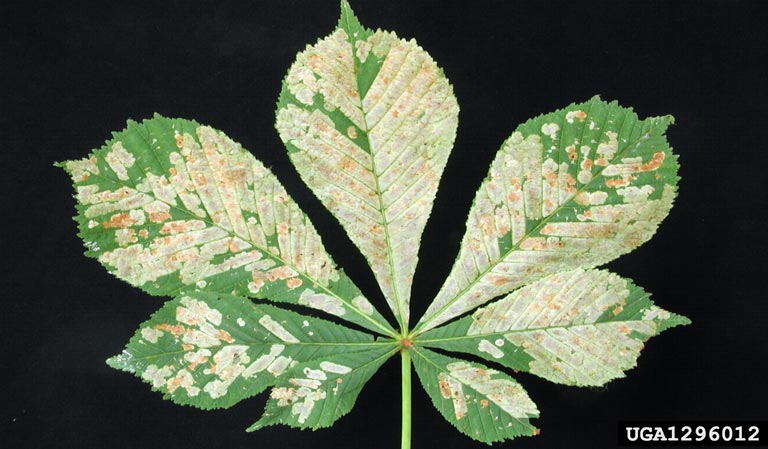
Picture: Gyorgy Csoka, Hungary FRI, Bugwood.org
These patches appear in the summer, sometimes as early as June, and begin in the lower canopy, as in the picture below, eventually spreading upwards to cover the entire tree.
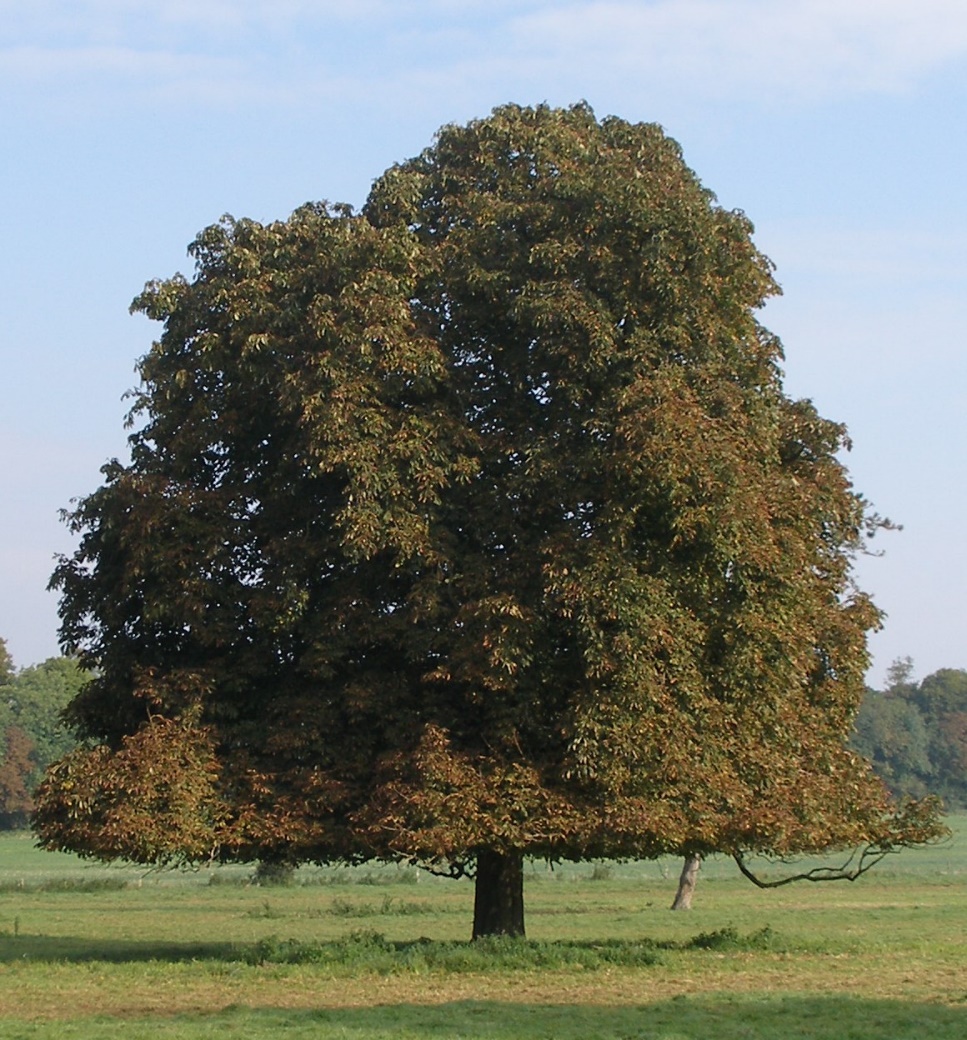
The effect can be to give the trees the appearance of under-going an early autumn, as in the picture below.
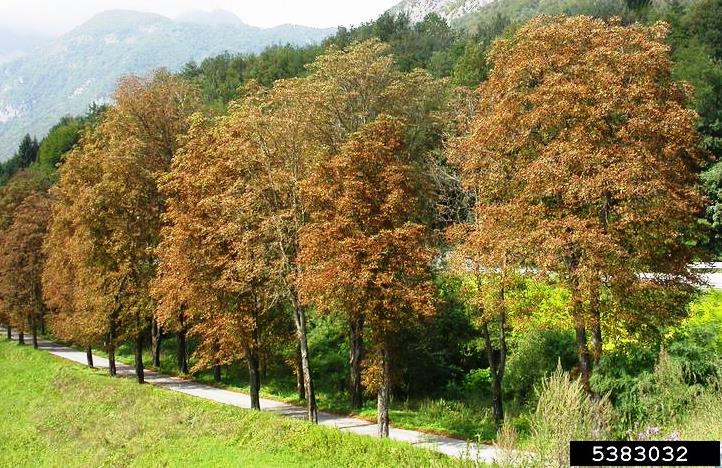
Picture: Fabio Stergulc, Università di Udine, Bugwood.org
So much of the foliage can turn brown by late summer that the tree appears to be dying, but owners should not draw this conclusion without first investigating whether other factors are involved.
At first glance the brown patches made by HCLM (below left) can be confused with those made by horse chestnut leaf blotch (below right). Leaf blotch is caused by a fungus called Phyllosticta paviae (also known as Guignardia aesculi). However, Phyllosticta blotches have a distinctive yellow border around parts of them, and are otherwise a more reddish-brown.
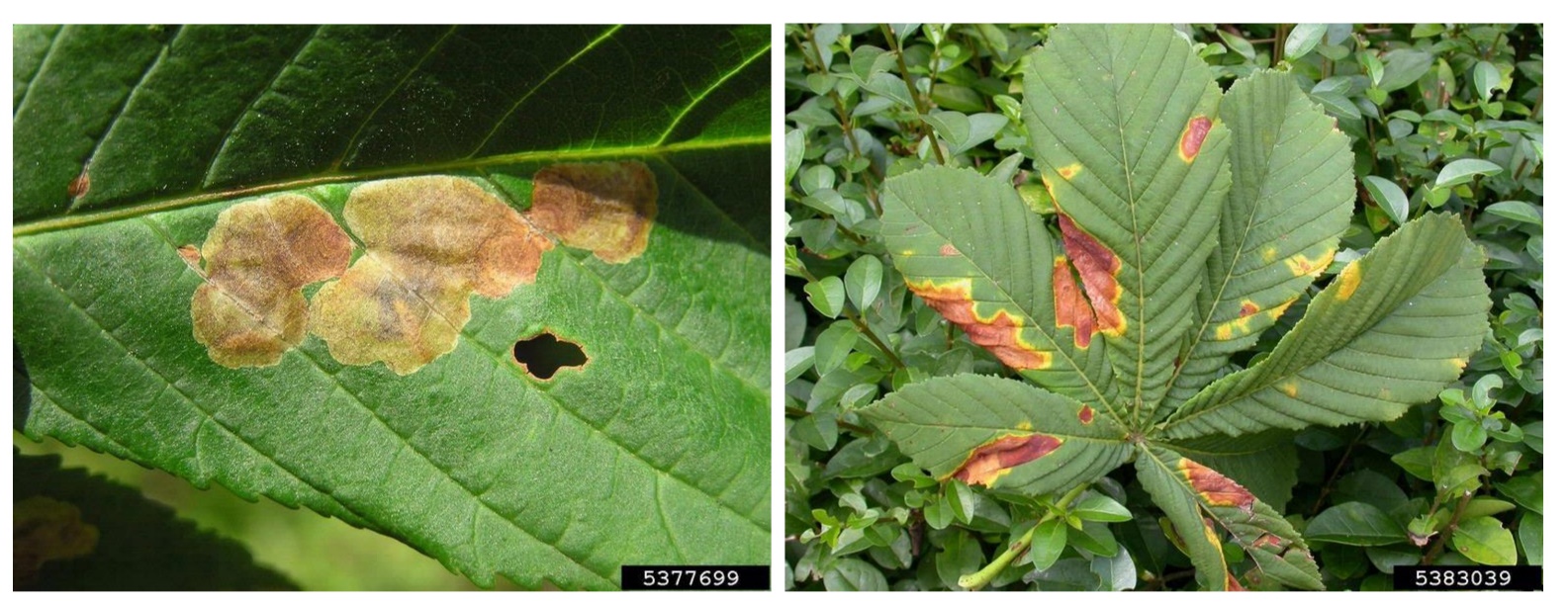 Pictures, above left: Milan Zubrik, FRI, Slovakia, Bugwood.org;
Pictures, above left: Milan Zubrik, FRI, Slovakia, Bugwood.org;
above right: RTECtreecare.com
Trees can be affected simultaneously by horse chestnut leaf miner and leaf blotch.
Heavily infested trees can drop their leaves early, before autumn.
Another view of severely damaged leaves (below).
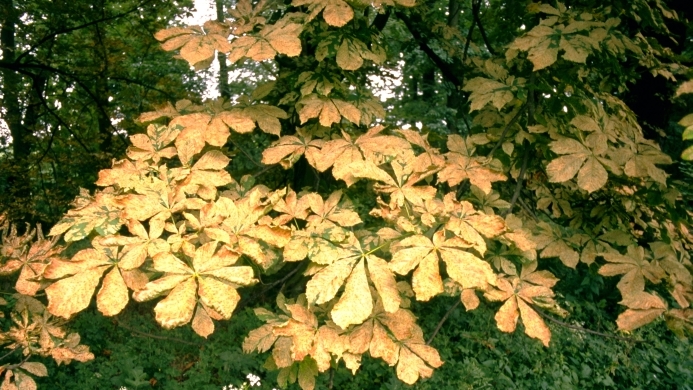
Picture: Petr Kapitola, Central Inst for Supervising and Testing in Ag, Bugwood.jpg
Trees in urban areas can be badly affected by leaf scorch (browning), particularly where there is heavy traffic flow, root compaction, spring droughts, or unseasonably high temperatures. This occurs where water loss through the leaves is too high for the roots to compensate, and they die from dehydration. Scorched leaves will be almost completely brown without any mines or halos.
Moths
Horse chestnut leaf miner moths – the adult stage of the species’ life cycle – are tiny, being only about 0.5 cm (0.2 inches) long; brown and silver; and have a wingspan of about 1 cm (0.4 inches). See top picture.
There is no requirement to report sightings of horse chestnut leaf miner to the plant health authorities, but records from Scotland can be submitted to us through TreeAlert for research and monitoring purposes
Dispersal of the moth from infested areas occurs on a broad front through adult flight, assisted by the wind, and through the passive transport of adult moths or infested leaves in or on vehicles. Transportation by vehicles is the most likely explanation for the sudden appearance of the moth in places a long way from known areas of infestation.
Wherever it has established, as seen in mainland Europe, it has built up high population densities, and spread at a rate of 40 to 70 kilometres per year. However, any further spread in the UK is now likely to be extremely slow and mediated by climate.
Adults (moths) appear from April onwards, emerging after over-wintering as pupae in leaf litter, and will subsequently mate during the early mornings.
Between May and August, females will lay between 20 and 40 eggs near or along the lateral veins of horse chestnut leaves. From here, these eggs will take two to three weeks to hatch.
The larvae which emerge from the eggs tunnel or ‘mine’ into the leaves, living between the two epidermis layers (outermost layers of the leaf) and eating the contents between, producing the symptomatic brown patches on the host leaves.
Larval development can take up to four weeks to complete before pupal development occurs, where a silken cocoon is formed inside the mine, and adults will emerge about two weeks later to repeat the cycle.
HCLM pupae can survive winter temperatures as low as -23 degrees centigrade. In the UK’s climate of mild, wet summers, two or three generations per year is normal, with each generational period taking from seven to 10 weeks to complete (from egg to adult) during the summer.
However, five generations per year can be achieved in warmer, dryer climates outside the UK. The moth’s high fecundity and multiple generations a year can lead to high population densities, and in mid- and late summer the brown patches caused by larval feeding coalesce until nearly the entire tree has brown leaves, resulting in the characteristic ‘early autumn’ appearance in the picture above.
The leaves will eventually drop, and the replacement leaves can then be attacked by the following generation of HCLM.
In the UK, it is usually the pupae of the final generation of the year that will enter diapause to over-winter as pupae before emerging the following year. However, if the population density is very high, overcrowding can cause individuals of the first and second generations to enter an early diapause and delay emergence until the next spring. (In severe infestations, more than 100 larvae can be found within each leaflet of a horse chestnut leaf). This means that at least some individuals survive to the following year and re-establish the population.
The pupae of horse chestnut leaf miner over-winter in the fallen leaves of horse chestnut trees. Therefore damage can be minimised by raking up fallen leaves during the autumn and winter, where this is practicable. They should then be burned (where this is permitted), or thoroughly composted, in sealed bags if possible, until the following July to destroy the pupae. These actions will break the species’ life cycle and reduce the population of the next year’s generation.
Clearing leaves from around the tree is a sufficient control in many cases. Horse chestnut trees in urban areas are often less affected, because the leaves are more likely to be cleared away, and the leaves of trees in exposed park land are typically blown away or mown over.
Some bird species, such as tits, prey on horse chestnut leaf miner, and a number of parasitoids attack the caterpillars. However, none is thought likely to make a significant difference to populations of the pest.
There is not a strong reason to employ pesticides as a control method, because HCLM does not significantly harm the trees’ overall health, and can be easily dealt with using the method above. Spraying and other insecticide application methods are unlikely to be completely effective, and will have damaging impacts on non-target bees and other pollinators which visit horse chestnut flowers.
Removing and destroying the fallen leaves is therefore the cheapest and most environmentally friendly method currently available for dealing with HCLM.
It is possible that differences in climate, or interactions with other pests and diseases, might lead to horse chestnut leaf miner’s having greater impact in the UK. Forest Research scientists are therefore conducting a long-term monitoring study of more than 300 horse chestnut trees at several sites in southern England.
The study aims to determine whether there are any interactions between horse chestnut leaf miner and the bacterium Pseudomonas syringae pv. aesculi, which causes most cases of bleeding canker of horse chestnut. The trees are assessed twice each year for infestation, crown condition, growth and signs of dieback.
The study’s objectives include assessing whether one influences the extent of the other, and how they affect the health of affected trees. A paper reporting the results of the first 10 years of the study was published in the journal Agricultural & Forest Entomology.
Currently the research indicates that although there might be a reduction in conker size, long-term defoliation by horse chestnut leaf miner does not have an impact on tree growth or health, and nor does it increase susceptibility to bleeding canker.
Data collection has continued, and an update will be published when the next 10 years’ data have been fully collected and analysed.
The HCLM’s native range is thought to be the Balkan region of south-eastern Europe. Mitochondrial and microsatellite DNA analysis has confirmed that all invasive European populations of HCLM originate from this region, which is also the native range of the European horse chestnut tree.
HCLM was first observed in Macedonia, in Northern Greece, in 1984, and was described as a new species in 1986 (Deschka & Dimić, 1986). However, earlier examples of leaves with leaf miner damage, in one casing dating back to 1879, have been reported in herbaria (collections of preserved plant specimens).
It was reported in Austria in 1989, and since then it has spread throughout Central and Western Europe. In 2002, it was discovered in the London Borough of Wimbledon, and has since spread throughout England and Wales.
There have been four reported sightings in Scotland, three of which were in Edinburgh, although a follow-up visit to the affected tree outside Edinburgh in 2019 failed to locate any mines on the tree. Any additional reports from Scotland would be welcomed. See ‘Report a sighting’ above.
Page updated August 2020
Straw, N. A., & Williams, D. T. (2013). Impact of the leaf miner Cameraria ohridella (Lepidoptera: Gracillariidae) and bleeding canker disease on horse-chestnut: direct effects and interaction. Agricultural and Forest Entomology, 15(3), 321-333.
Pocock, M., Evans, D., Straw, N., & Polaszek, A. (2011). The horse-chestnut leaf-miner and its parasitoids. British Wildlife, 22(5), 305.
Koskella, B., Meaden, S., Crowther, W. J., Leimu, R., & Metcalf, C. J. E. (2017). A signature of tree health? Shifts in the microbiome and the ecological drivers of horse chestnut bleeding canker disease. New Phytologist, 215(2), 737-746.
Valade, R., Kenis, M., Hernandez‐Lopez, A., Augustin, S., Mari Mena, N., Magnoux, E., … & Lopez‐Vaamonde, C. (2009). Mitochondrial and microsatellite DNA markers reveal a Balkan origin for the highly invasive horse‐chestnut leaf miner Cameraria ohridella (Lepidoptera, Gracillariidae). Molecular Ecology, 18(16), 3458-3470.
Straw, N. A., & Tilbury, C. (2006). Host plants of the horse-chestnut leaf-miner (Cameraria ohridella), and the rapid spread of the moth in the UK 2002–2005. Arboricultural Journal, 29(2), 83-99.
Thalmann, C., Freise, J., Heitland, W., & Bacher, S. (2003). Effects of defoliation by horse chestnut leafminer (Cameraria ohridella) on reproduction in Aesculus hippocastanum. Trees, 17(5), 383-388.